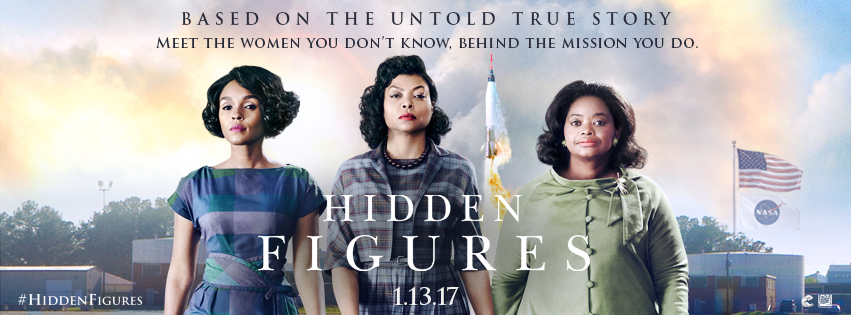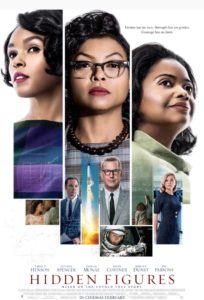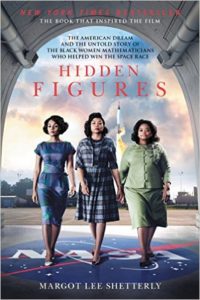Welcome back to Sound Off!, a semi-regular column where members of Speculative Chic gather together to chat about the latest BIG THING in entertainment. This time, we’ve participated in the space race in order to discuss Hidden Figures, which premiered in the United States on Friday, January 6, 2017.

Sound Off! is meant to be a group of reactions, but not necessarily a review. After all, while we are all individuals, even mutual love of something (or hate) can come from different places. You may find everything from critique to fangirling to maybe even hate-watching, but it’s safe to say that if you haven’t yet seen Hidden Figures and you read this post, you WILL be spoiled in some form or fashion.
Now, join Nancy and J.L. Gribble as they talk about Hidden Figures!
 Nancy: About halfway through watching Hidden Figures, I began to realize that there was one phrase — or variations on it — that was being repeated a lot. “That’s just how things are,” or “It’s never been done before.” These phrases, spoken by characters in position of privilege (either due to race or gender), really illustrate how Hidden Figures has chosen to display prejudice in this film. Not in a loud, overtly hateful way, but by shining a light on the damaging pervasiveness of the broken status quo. We watch as our three leads (all women of color) are forced to jump through ridiculous hoops thanks to the walls society has set up around them. A big example of this can be found in the scenes where Katherine must run a quarter mile across the campus at NASA every time she needs to to use the bathroom, just so she can find a “colored” facility. And meanwhile, everyone who benefits from this type of society just sits back and makes excuses about their hands being tied by the system. Hidden Figures sends a strong message that society as a whole must change to allow for equality, not just for the good of the individuals who will be risen up due to these changes, but for the benefit of the world as a whole. Because it takes us all working together to accomplish something groundbreaking, such as sending a man into space.
Nancy: About halfway through watching Hidden Figures, I began to realize that there was one phrase — or variations on it — that was being repeated a lot. “That’s just how things are,” or “It’s never been done before.” These phrases, spoken by characters in position of privilege (either due to race or gender), really illustrate how Hidden Figures has chosen to display prejudice in this film. Not in a loud, overtly hateful way, but by shining a light on the damaging pervasiveness of the broken status quo. We watch as our three leads (all women of color) are forced to jump through ridiculous hoops thanks to the walls society has set up around them. A big example of this can be found in the scenes where Katherine must run a quarter mile across the campus at NASA every time she needs to to use the bathroom, just so she can find a “colored” facility. And meanwhile, everyone who benefits from this type of society just sits back and makes excuses about their hands being tied by the system. Hidden Figures sends a strong message that society as a whole must change to allow for equality, not just for the good of the individuals who will be risen up due to these changes, but for the benefit of the world as a whole. Because it takes us all working together to accomplish something groundbreaking, such as sending a man into space.
There is so much that Hidden Figures has to offer. For one thing, it’s great that the stories of these three women of color — Katherine (Goble) Johnson, Dorothy Vaughan, and Mary Jackson — are being brought to the wider world. All three characters are played wonderfully by three talented actresses — Taraji P. Henson, Octavia Spenser, and Janelle Monae, who are then surrounded by a strong supporting cast. I love the fact that alongside being a story about race, Hidden Figures is also a story about the power of smarts, focusing on STEM fields such as mathematics, engineering, and computer programming. Movies about going to space often focus on the explorations of likable, brave astronauts (and Hidden Figures has one of those as well!), but this movie instead chooses to focus on the amount of thought and calculations that go on behind the scenes, showing us just how much work it really takes to go to space.
Hidden Figures has been criticized for sticking to the biopic formula a little too religiously, and while there is some legitimacy to that claim, I think the movie has enough going for it to keep it from feeling generic. The stories told here are certainly worthwhile, the performances are consistently top notch, and the film’s exploration of the space race is both informative and entertaining. I highly recommend checking this out if you have any interest in the space race, or the shifting role of women of color in society. I enjoyed every minute of it.
 J.L. Gribble: As someone who once wanted to be an astronaut, still regularly geeks out about the space program, and supports expanded diversity in both fiction and real life, I knew that I needed to see Hidden Figures. While discussion of this film might seem out of place on a website dedicated to speculative fiction, I think this movie’s inclusion is important because the creation of movies like this doesn’t mean that the barriers have disappeared. Instead, they are subtler, more insidious, and just as dangerous, including in the realms of STEM fields and speculative fiction fandom.
J.L. Gribble: As someone who once wanted to be an astronaut, still regularly geeks out about the space program, and supports expanded diversity in both fiction and real life, I knew that I needed to see Hidden Figures. While discussion of this film might seem out of place on a website dedicated to speculative fiction, I think this movie’s inclusion is important because the creation of movies like this doesn’t mean that the barriers have disappeared. Instead, they are subtler, more insidious, and just as dangerous, including in the realms of STEM fields and speculative fiction fandom.
As a story, Hidden Figures was chock full of excellent writing that focused on all three of the main characters without sacrificing the plots of any of them. While I had expected two of the characters to be mere supportive friends in the life of Katherine, I instantly fell in love with Mary and Dorothy’s storylines as budding engineer and computer programmer, as well. This proves that unconscious bias can exist even in people who try to be open-minded. In this case, it was because I didn’t believe Hollywood could focus on more than one story at a time about a black woman breaking down barriers. I came into the theater expecting this movie to reinforce institutional racism by making Katherine the exception rather than representative.
Instead, all three women are fully developed characters. This includes lives and families outside of their careers, breaking down another trope that successful, intelligent career women exist only in the vacuum of their jobs. Hidden Figures passes the Bechdel Test with flying colors while still including a full romantic subplot that had me just as invested in the outcome as the other stories.
In various parts, this movie made me cheer, made me cry with joy, and made me uncomfortable. While it would be easy to focus on the first two and celebrate the characters’ successes, it is the latter that is the most important in the long run. It is the job of storytellers to transport us into the shoes of those other than ourselves, and as someone who benefits from white privilege, I’m glad that this movie did such an exceptional job of creating that discomfort in me during the scenes of such casual (and more overt) racism. In fact, this discomfort is what makes me want to delve deeper into the story of this movie. While Katherine checking Col. John Glenn’s flight numbers after the computer is established fact, how much of the “smaller” scenes that I cheered for actually happened? Did Col. Glenn actually shake hands with the black female computing department at the far side of his receiving line? Did Al Harrison actually desegregate NASA’s bathrooms?
Hidden Figures is more than just a feel-good historical film that celebrates diversity. It is a solid story that entertains, brings you back to an important period of human history, and makes you think. These things are just as important to watch as speculative fiction escapist brain candy (and I’ll be the first person to defend my escapist brain candy). Hollywood: You’ve shown that you can do better. It’s time to increase the number of speculative fiction films featuring main characters who are not white cisgender men. If Katherine Johnson can exist in real life, she can exist in our collective imagination, as well.

I would really like to go see this. I may have to wait for it on iTunes, though….
JL- I also found myself wanting to know how much it was really “based” on the true story- such as the bathroom desegregation scene. After The Imitation Game, I just don’t know how much “truth” I should expect. I hope to read the Hidden Figures book sometimes in the future, at least.
Granted, I HAVE heard that John Glenn was a super-nice. Apparently, he died right before the movie was ready for him to watch
I snagged the book when it was a Kindle Daily Deal a couple days ago. Your discussion definitely made me want to go see the movie, AND read the book sooner rather than later!
Glad to hear it! I hope you enjoy it as much as we did